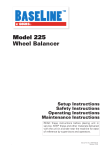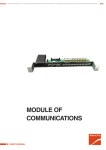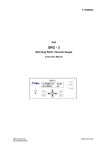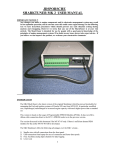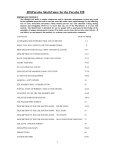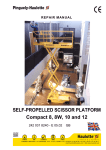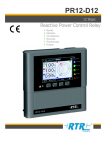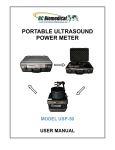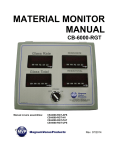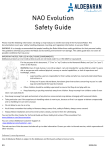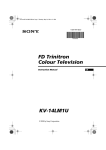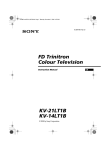Download Manual
Transcript
TreadPlus B30 OPERATOR‟S MANUAL KJC Engineering Canada Inc. 1 Index TRANSPORT, STORAGE AND HANDLING ........................................................................................ 4 INSTALLATION ........................................................................................................................................ 4 HEAD ASSEMBLY ....................................................................................................................................... 5 GUARD ASSEMBLY (FIG.3) ......................................................................................................................... 5 MAIN OPERATING COMPONENTS (FIG.4)..................................................................................................... 5 DISPLAY PANEL (FIG.4A) ............................................................................................................................ 6 ELECTRICAL HOCK-UP ........................................................................................................................ 6 SAFETY REGULATIONS ........................................................................................................................ 7 GENERAL CHARACTERISTICS ........................................................................................................... 8 TECHNICAL SPECIFICATIONS ........................................................................................................... 8 GENERAL CONDITIONS OF USE ......................................................................................................... 9 SWITCHING ON THE BALANCER..................................................................................................... 10 WHEEL DATA INPUT ............................................................................................................................ 10 VERSION WITHOUT AUTOMATIC GAUGE................................................................................................... 10 UNBALANCE DISPLAY IN GRAMS OR OUNCES ........................................................................... 11 ROUNDING .............................................................................................................................................. 11 WHEEL SPIN ........................................................................................................................................... 11 BALANCING PROGRAMS.................................................................................................................... 12 DYNAMIC BALANCING (STANDARD) ........................................................................................................ 12 STATIC BALANCING ................................................................................................................................. 12 BALANCING ALUMINIUM WHEELS ........................................................................................................... 13 -STANDARD ALU PROGRAMS .................................................................................................................. 13 BALANCING ALUMINIUM WHEELS-ALU P PROGRAMS ............................................................................. 13 BALANCING MOTORCYCLE WHEEL .......................................................................................................... 16 BALANCING CTS WHEEL ........................................................................................................................ 16 THE OPT OPTIMIZATION PROGRAM (OPTIONAL) .................................................................... 16 OPT 1 ..................................................................................................................................................... 17 OPT 2 ..................................................................................................................................................... 17 OPT 3 ..................................................................................................................................................... 17 OPT 4 ..................................................................................................................................................... 18 QUICK OPT PROGRAM ....................................................................................................................... 18 CALIBRATION PROGRAM .................................................................................................................. 19 FIRST SENSITIVITY CALIBRATION............................................................................................................. 19 SECOND SENSITIVITY CALIBRATION ........................................................................................................ 19 2 DISPLAY MESSAGES ............................................................................................................................ 20 ERROR DISPLAY....................................................................................................................................... 20 OTHER MESSAGES ................................................................................................................................... 21 USING THE PEDAL BRAKE TO HOLD THE SHAFT IN POSITION ............................................ 21 BALANCING ACCESSORY AVAILABILITY STATUS ...................................................................... 21 TROUBLE SHOOTING .......................................................................................................................... 22 GLOSSARY .............................................................................................................................................. 23 DIAGRAMS .............................................................................................................................................. 24 GENERAL ELECTRIC LAYOUT ................................................................................................................... 24 3 Transport, Storage and Handling The balancer packaging consists of a wooden crate and pallets. Before installation, the balancer must be transported in its original packing by inserting the forks of a lift truck in the relevant channels in the pallet, making sure that the machine is maintained in the position indicated on the outer packing(fig.1). Machine packing dimensions Length 1060mm Depth 760mm Height 1200mm Shipping weight with packing 132Kg Ambient conditions in place of storage: Relative humidity form 20% to 95% Temperature from -10 to +60℃. Attention Do not place other items on top of the two packs, as this may cause damage. After installation, the machine can be moved using the following methods: With a crane, using special equipment that holds the machine at the lifting points(fig.1a); Positioning the machine on its original pallet, securing it with the original devices and then lifting the pallet with the lift truck. Attention Always unplug the power supply lead from the socket before moving the machine. Warning Never apply force to the spin shaft when moving the machine. Installation Warning Take the utmost care when unpacking, assembling, and setting up the machine as described in this heading. Failure to observe these instructions can lead to damage to the machine and injury to the 4 operator or other persons. Remove the original packing once you have positioned it as shown on the outside and keep it intact for possible future transport. Choose the place of installation in strict observance of local regulations regarding safety in the workplace. Attention If the machine is to be installed outdoors, it must be properly protected by a canopy roof. Ambient conditions in the place of operation: Relative humidity from 30% to 95% Temperature range from 0℃ to +55℃ Warning The machine must not be operated in explosive atmospheres. Place the machine in the chosen position and make sure that the surrounding space is commensurate with the minimum clearances indicated in figure 2. The machine is supplied with a number of separate parts that have to be assembled, following the procedures described below. Head assembly Remove the two brackets that attach the head to the cover; Turn the head over and insert the pins that protrude from the base of the head, fitting them into the correct holes in the weight-holder cover; Turn the head anti-clockwise to lock it. Guard assembly (fig.3) Unscrew the nuts that lock the two bolts on the guard support pin holes and take out the bolts; Fit the guard tube into the support pin, lining up the two sets of holes Fit the two bolts into the holes and attach the guard on to the support by tightening up the nuts. Main operating components (fig.4) A B C D E distance gauge rotating display display panel with keyboard flange-holder cover weight-holder cover 5 F G H brake pedal master switch QL pedal Display panel (fig.4a) A B C D E F inside plane display (left) outside plane display (right) inside plane position indicator outside plane position indicator keys and leds for selecting and displaying available programs key and led for input of wheel data Electrical hock-up On request, the balancer can be set up by the manufacturer to operate with the power supply available in the place of installation. The set-up details for each individual machine are given on the machine data plate and on a special lavel attached to the power supply connection lead. Warning All the electrical hock-up operations must be carried out solely by specialized personnel. The electrical hook-up is scaled according to the balancer‟s electrical power input, as specified on the machine data plate. A plug conforming to binding regulations must be fitted to the power supply cable. The machine must have its own electrical connection with an automatic differential switch set to 30mA. To set the scale of the protection fuses on the power supply line, refer to the general electric lay-out in this manual. To prevent the machine from being used by non-authorized personnel, it is advised to unplug the power supply plug when the machine is not being used (switched off) for long periods. If the power supply line is connected directly to the main electricity panel, without a plug, a key switch or lockable switch must be fitted, to restrict the use of the machine to authorized personnel only. Warning A good ground connection is essential for the correct functioning of the machine, NEVER connect the machine ground wire to a gas pipe, water pipe, telephone cable or other unsuitable objects. 6 Safety regulations Warning Failure to observe these instructions and the relative danger warnings can cause serious injury to the operator and others. Do not power up the machine before you have read and understood all the danger/warning/attention notices in this manual. This machine must be used only by qualified and authorized personnel. A qualified operator is construed as a person who has read and understood the manufacturer‟s instructions, is suitably trained, and is conversant with safety and adjustment procedures to be adhered to during operations. Operators are expressly forbidden form using the machine under the influence of alcohol or drugs capable of affecting physical and mental capacity. However, in the case of drugs prescribed by a qualified physician without contraindications, the operator may be allowed to use the machine. The following conditions are essential: The operator must be able to read and understand the contents of this manual; Make sure the operator has a thorough knowledge of the capabilities and characteristics of this machine; Keep unauthorized persons well clear of the area of operations; Make sure that the machine has been installed in compliance with established legislation and standards; Make sure that all machine operators are suitable trained, that they are capable of using the machine correctly and that they are adequately supervised during their work; Do not touch power lines or the inside of electric motors or other electrical equipment until the power has been disconnected and locked out. Read this manual carefully and learn how to use the machine correctly and safely; Always keep this user manual in a place where it can be readily consulted when working with the machine and consult it whenever you are in need of confirmation or explanations. Warning Do not remove or deface the safety Danger, Warning or Instruction decals. Replace any missing or illegible Danger, Warning or Instruction decals. When using and carrying out maintenance on the machine observe the unified industrial accident prevention regulations for high voltage industrial equipment and rotating machinery. Any unauthorized alterations made to the machine automatically release the manufacturer from any liability in the case of damage or incidents attributable to such alterations. Specifically, tampering with or removing the machine‟s safety devices is a breach of the regulations for industrial accident prevention. 7 Attention During work and maintenance operations, always tie up long hair and do not wear loose or flappy clothing, ties, necklaces, wristwatches or any other items that may get caught up in the moving parts. General characteristics Single spin, fixed position flange balancing machine Microprocessor controlled data processing central unit Unbalance displayed grams and ounces Unbalance value detection precision:1gram (1/10 oz) Slow balancing speed (150 rpm) Full function, built in keyboard Automatic wheel clamping system (optional) Foot pedal brake operating on shaft ass‟y Automatic start by pushing down on lowered wheel guard Handy side flange holder cabinet Cover with trays for all types of weights Mini-anvil to repair clip weights Lighted digital display to show: Unbalance weight and position Program selected Swivel display unit for optimum readout Wide selection of programs so that the machine is easy to use straight away Types of balancing available: Standard dynamic on both planes Static on a single plane ALU 5 different routines for aluminium rims Motorbike dynamic dynamic on both planes of motor-cycle wheels ALU motorbike dynamic on both planes of aluminium motorcycle wheels CTS dynamic for Continental tire system wheels OPT: program to reduce road noise by optimizing rim/tire match General utility programs: Calibration Self-diagnostic (servicing) Technical specifications Supply voltage……………………………………………………110/220V±10% single-phase Power draw……………………………………………………………………………… 250W 8 Balancing speed………………………………………………………………………… 150 rpm Average spin time(with 5*14”wheel) ………………………………………………………7 sec Shaft diameter…………………………………………………………………………… 38mm Tire shop temperature…………………………………………………………………… 0-50℃ Machine dimensions (fig.4b): Width with guard……………………………………………………… 1250mm Depth with guard closed…………………………………………………1030mm Depth with guard open……………………………………………… … 1150mm Height with guard closed…………………………………………… … 1280mm Height with guard open………………………………………………… 1680mm Programming parameters: Rim width………………………………………………………from 1.5” to 20” Rim diameter……………………………………………………… from 1”to 23” Max.wheel/machine distance………………………………………… …170mm Max.wheel width(with guard) ……………………………………………400mm Max.wheel diameter (with guard) …………………………………… …870mm Max.wheel weight……………………………………………………………65kg Shipping weight (without accessories) ……………………………………… …114kg Noise level when running………………………………………………… … <70dB(A) General conditions of use The balancers described in this manual must be used exclusively to measure the entity and position of unbalances on motor vehicle wheels, within the limits specified in the “Technical Brief”. Furthermore, versions with motor must be lowered during the spin operation. Attention Any use of the machine other than the described use is to be considered as improper and unreasonable. Warning It is forbidden to start the machine without the equipment for blocking the wheel. Attention Do not use the machine without the guard and do not tamper with the safety device. 9 Attention Get to know your machine: the best way to prevent accidents and get the best performance out of the machine is to ensure that all the operators know how it works. Learn the function and location all the commands. Carefully check that all the commands on the machine are working properly. To avoid accidents and injury, the machine must be installed properly, operated correctly and serviced regularly. Switching on the balancer Turn on the machine with the master on the back of the cabinet (G. Fig.4). After the beep, and the lamp test, the machine is ready to receive the wheel data. Wheel data input Version without automatic gauge Press key The machine is ready to receive the WIDTH (the corresponding LED will light) Measure rim width with the caliper (Fig.5) Change the number shown on the right display using the and keys until the correct number is set. WIDTH can be input in millimeters or a previous input converted to inches. To 。 do this press. To return to input in inches hit again. A LED on the panel will light to identify the current unit of measurement(mm or inch). Press again to confirm the input and to set up the machine for DIAMETER: (the corresponding LED will light) Read the rim diameter on tire Change the number on the right display with the and keys until the correct number is shown. DIAMETER can be input in millimeters or a previous input converted to inches. To do this press. To return to input in inches hit again. A LED on the panel will light to identify the current unit of measurement (mm or inch). Press key corresponding LED will light) Move the distance gauge until it touches the edge of the inside rim channel as shown in fig.6 or 6a according to the different terminal available on the gauge. a third time to confirm the input and set up the machine for DISTANCE (the 10 Read the machine/rim distance on the ruler Change the number shown on the right display by pressing the correct setting is shown. and keys until the If you hold down the and keys the numbers will spool up or down quickly and make data input all the more rapid. Once the wheel data have been input correctly press: to display the unbalance (recalculated for the new wheel data); START to do a spin. Unbalance display in grams or ounces You can set up the machine to display unbalance values in grams or ounces by pressing the and holding it down for about five seconds. key Rounding When the machine is switched on its default setting is to show the unbalance to the nearest five grams (rounding up or down as necessary) or to the nearest 1/4 ounce if data output in ounces has been set. In this default setting, the first 4grams are not displayed since they are regarded as below the operational threshold ( the „Thr‟ LED will turn off) and the unbalance will be shown to the last gram (or to the last 1/10 of an ounce if this display made is active). Each time the key is press, the machine toggles between threshold ON and threshold OFF. Wheel spin A safety device prevents the rotation of the wheel when the guard is open and stops the rotation if the guard is opened during the spinning. Attention Never raise up the guard before the wheel has come to a stop. If, due to a fault in the machine, the wheel keeps spinning permanently, switch off the machine at the master switch or by unplugging the plug from the power supply panel (emergency stop). Then wait until the wheel stops, or apply the brake with the pedal. 11 Balancing programs Before starting a balancing cycle: Mount the wheel on the shaft using the appropriate flange Remove any balancing weights, stones, dirt or other foreign bodies from the wheel Input wheel data correctly. Dynamic balancing (standard) Press the keys until the LED for DYN balancing program lights. Press to confirm your choice. Dynamic balancing mode is the default setting when the machine is switched on. Input the wheel data correctly. Spin the wheel by pushing down on the guard. For best balancing results do not rush the machine while it is processing the unbalance signals. Wait for the beep signaling that the data processing has been completed. Brake the wheel with the pedal brake (F, fig.4) The unbalance weights will be shown on display A and B (fig.4a) for the inside and outside planes respectively. Choose the fist side you intend to balance and turn the lights and you will also hear a confirming beep. The display will flash. Put the balancing weight at 12 o‟clock. Repeat this process for the other side of the wheel. Make a test spin to check the accuracy of the balancing. If you do not find it completely to your satisfaction, change the amount of the weight and its position following the suggestions given in the „balancing check diagram‟ (fig.7). Do not forget that especially when the unbalance is large, a slight error (a degree or two) in positioning the balancing weight can produce a residual unbalance of 5-10g. Static balancing A wheel can also be balanced with a single weight placed on one of its sides on at the centre of the channel. This is what is called static balancing. Some dynamic unbalance may still be present (shimmy) and the wider the tire, the more noticeable this will be. Press the keys until the LED for static balancing lights. Press to confirm your choice. Input the diameter of the wheel (in static mode you need only input the diameter). Spin the wheel by pushing down on the guard. Wait until you hear the beep signaling that the unbalance has been calculated. Brake the wheel with the pedal brake (F fig.4). The unbalancing weight will appear on the display (B fig.4a). 12 Turn the wheel unit it the segment at the centre lights to show the correct position has been reached and you hear the beep. The display will also flash when the correct position has been reached. Place the weight as indicated at 12 o‟clock on either side or at the centre of the rim channel. If you decide on the rim channel, remember that the diameter is less than the nominal and for good results, when you input the diameter value, make it 2 or 3 inches less than the nominal. Do a test spin following the same procedures as for standard balancing. Balancing aluminium wheels -standard ALU programs To balance aluminium wheels we usually use self-adhesive weight and these are positioned differently from the clip weights used in standard balancing. The 5 ALU programs bear in mind the various positions for the weights (fig.8) and provide correct unbalance values while maintaining unchanged the wheel data input for aluminium rims. Press the keys until the LED for the ALU program lights. Press the number of times needed to confirm your choice of ALU programs (the circle on the panel illustrates the type of weights and balancing planes for each ALU program) Input the wheel data. If the width you input is less than 4” or the diameter less than 11”, the message Alu Err may appear. This means that the width and diameter input cannot be used for the ALU program selected. Once you have selected the program you want and have input the wheel data correctly, follow the procedures explained under the sections on standard balancing. Some slight residual unbalance may remain at the end of the test spin due to the considerable difference in shape found in rims with the same nominal diameters. To counter this, change the amount and position of the weights in accordance with the blance check diagram (fig.7) until you have as accurate a balance status as you can get. Balancing aluminium wheels-ALU P programs In order to reduce the inaccuracy of results that may sometimes occur with the standard ALU programs, especially in the most critical cases (programs ALU 1 and ALU 2), you can use the programs ALU 1P and ALU 2P. These can be selected in the usual manner in the ALU program sequence, with these programs you have to set the real wheel data rather than the nominal values as in standard ALU programs. This means that four data items have to be entered: Diameter and distance with respect to the inside wall measured and entered automatically by the appropriate gauge; Diameter and distance with respect to the outside wall, measured using the gauge (fig.8a) and entered via the keyboard. 13 Measuring wheel data Move the internal automatic gauge to the plane chosen for fixing the inside balancing weight (fig.8b for ALU 1P and fig.6 for ALU 2P). Make absolutely certain the gauge is positioned correctly so as to ensure accurate reading of data. Keep the gauge in contact with the rim until the machine has acquired and displayed the wheel diameter and distance values. Return the gauge to its rest position. Position the mobile gauge on the right side of the vehicle body using the special attachments (1.fig.8c). Extend the telescopic arm until the centre of the weight-holding spring (located at the end of the arm) is at the plane chosen for fixing the outside balancing weight (2. fig.8c). Push the sliding arm towards the rim until the spring (located at the end of the arm) rests against the rim itself (3. fig.8c). If necessary adjust the position of the telescopic arm so that it is possible to fix the weight onto the chosen plane (check that there are no discontinuities at the centre of the weight-holding spring that might prevent the weight from being fixed on correctly) Read off the distance from the vehicle body on the graduated scale (F. fig.8a) located on the telescopic arm, and the diameter on the graduated scale (G. fig.8a) located on the fixed part of the gauge. Remove the mobile gauge from the measuring position. In order to retain the measured values make sure you do not change the setting of the moving parts. Press the The machine is now ready to receive the EXTERNAL DISTANCE input. Change the displayed value by pressing the keys until the display shows the distance you have just read. Press the key. key again. The machine is now ready to receive the EXTERNAL DIAMETER input. Change the set value by pressing the keys until the display shows the diameter you have just read. You can display the DIAMETER in millimeters or convert previously set values from inches to millimeters by pressing the key. By keeping the keys pressed down you can raise or lower previously set values very quickly. Once you have set the wheel data correctly, press to display the unbalance (recalculated for the new wheel data) or START to do a spin. If the automatic gauge does not work, you can enter all wheel data from the keyboard. First enter the external distance and the external diameter as described above, then proceed as follows: Press the key again to confirm the previous data. The machine is now ready to receive the internal distance input. 14 Move the internal automatic gauge to the plane chosen for fixing the inside balancing weight (fig.8b for ALU 1P and fig.6 for ALU 2P). Read off the distance between the wheel and the vehicle body on the graduated scale. Change the set value of the diameter by pressing the keys until the number you have read is displayed. Press the key again to confirm the previous data. The machine is now ready to receive the INTERNAL DIAMETER input. Read off the nominal value of the rim diameter on the tire. Change the set value of the diameter by pressing the keys until the number read is displayed. In ALU 1P you have to set an Internal diameter of one inch less than the nominal value given on the tire. You can set the diameter in millimeters or convert previous inputs from inches to millimeters by pressing the key. Finally press spin. to display the unbalance ( recalculated for the new dimensions) or START to do a Attaching balancing weights 1. inside wall Turn the wheel until the central position indicator segment lights up. Attach the balancing weight shown in the 12 o‟clock position. If the program ALU 1P is running, place the weight at the exact position of the plane chosen when measuring the wheel data. Fig.8b shows the correct position of the weight with respect to the end of the gauge. 2. outside wall Position the balancing weight shown inside the mobile gauge spring (D. fig.8a), making sure that it is centred with the adhesive part outwards. Remove the protective paper from the adhesive strip. Turn the wheel until the central position indicator segment lights up. Position the mobile gauge on the right side of the vehicle body using the special attachments (1, fig.8c) If necessary, push the sliding arm towards the rim until the spring (situated at the end of the arm) rests against the rim itself. Press the button E (fig.8a) to make the weight adhere to the rim which will therefore be correctly fixed in the 9 o‟clock rather than the usual 12 o‟clock position. Remove the mobile gauge from its case, taking care not to change the setting of the moving parts. This way it can be used for attaching weights to identical wheels. Perform a test spin so as to check balancing accuracy. 15 Balancing motorcycle wheel Motorcycle wheels can be statically balanced (following the steps outlined in the section on Static Balancing). If you want, you can divide the weight into two equal parts and place a weight on each side of the wheel. If the WIDTH of the tire (over 3 inches) is such as to generate considerable unbalance which cannot be eliminated with static balancing, it may be worthwhile doing a dynamic balancing (on both sides). Press the keys until the LED for DM balancing lights. Press to confirm your choice. Mount the wheel on the shaft using the specific flange. ATTENTION: for good results mount the wheel on the flange so that there is no slippage when the wheel is spun or braked since this will give inconsistent results. Install the extension (fig.9) on the distance arm. Input the wheel data as described previously. Balance the wheel following all the steps described under the section on Standard Balancing. To balance motorcycle wheels dynamically with adhesive weights: Press the Press twice to select ALU MOTO (the circle on the panel shows the types of weights and planes to be balanced in the various programs). Follow the instructions above for dynamic motorcycle wheel balancing. The unbalance will be calculated and displayed for the position you will actually use for the adhesive weight. keys until the LED for DM balancing lights. Balancing CTS wheel Special weights are used with these wheels and they are positioned between the tire edge and the seal ring. The CTS program makes its Unbalance calculations bearing this position in mind. Press the keys until the LED for the CTS program lights. Press to confirm your choice. Input wheel data as usual. Follow the standard dynamic balancing procedure. The opt optimization program (optional) This procedure is used to reduce road noise (vibrations) to a minimum. Road noise can still be present even after a very painstaking balancing but it can be reduced by elimination as much as possible any mismatch between tire and rim. Here the professional experience of the tire specialist comes into play. When you feel that this extra 16 step could be helpful to reduce road noise to a minimum, select this program. Press the keys until the OPT program LED lights. Press to confirm your choice. Once you have selected this program the machine will indicate whether it is worthwhile going through the OPT. To do this the machine will flash the message: Yes OPT if it is worth the effort No OPT if it is not. This decision is made on the basis of the unbalance found with the last spin made (therefore, the last spin must refer to the wheel on the machine). You can now ready to move into the first stage of the program and this will be signaled on the display, if you do not want to continue with this program, press the key. OPT 1 Mount the rim without the tire on the balancing machine Turn it until the valve (or hole) is at 12 o‟clock. Press . Make the first spin (as instructed by the displays). At the end of the spin, the program goes into its second stage. OPT 2 Remove the rim from the balancer Put the tire on the rim. Put the tire on the balancer Turn it until the valve is at 12 o‟clock (see fig.16) Press Make the second spin. At the end of the spin, the program goes into the 3rd stage of the OPT program. OPT 3 Turn the wheel until the segment in the middle of the screen lights up to indicate the position Make a chalk mark on the outside wall of the tire at 12 o‟clock Remove the wheel from the balancer Turn the tire on the rim until the chalk mark is opposite the valve (i.e.180°) Remount the wheel until the valve is at 12o‟clock Press Make the third spin At the end of the spin, the program goes into its fourth and last stage. 17 OPT 4 Turn the wheel until the segment in the centre lights to indicate the correct position Make two chalk marks on the outside wall of the tire at 12 o‟clock. If the screen gave you the message to switch around the tire as it is mounted on the rim, make these two chalk marks on the inside wall of the tire. Turn the tire on the rim (and switch it around if this is called for ) so that the two chalk marks are opposite to the valve Mount the wheel on the balancer Turn the wheel until the valve is at 12 o‟clock Press Make the 4th spin. When this 4th spin has finished the OPT program has been completed and the machine will display the weights to be added to balance the wheel. If you make an error which will negatively affect the end result, the machine will tell you this by, displaying a message: OPT Err. This means the entire procedure should be repeated from the beginning. Notes If you do not want to make the first spin with just the empty rim, you can skip the first phase by hitting the key immediately after pressing the key for the OPT program. This will mean that you start by mounting the rim plus tire on the balancer and carrying out phases 2, 3, 4 as previously described. At the end of the 2nd and 3rd spin you may get the message OUT 1or OUT 2 on the screen. This means that you are better off abandoning the program by pressing the key. The display will then give the weights needed to balance the wheel. This allows you to short cut the program by accepting the current status without going all the way. If you want to carry on the end, press the key and you will continue in the OPT program. At the end of the 3rd spin the screen may suggest switch the tire around on the rim. If you do not want to or cannot do this, press key. The screen will display instructions on how to complete the OPT program without making this switch. Quick OPT program In the vast majority of cases this program gives results almost as good as the full OPT program described above, although it requires fewer spins. Proceed as outlined above in the previous heading with the difference that the first stage of the quick optimization program corresponds to the second stage of the standard program. You therefore start work with the tire already on the rim and then proceed with the successive stages. 18 Calibration program First sensitivity calibration This program needs to be run whenever the settings appear to be out of tolerance or when the machine requests self-calibration spontaneously by displaying the message “Er1 CAL”. Select a wheel of average size and weight,(preferably with a limited unbalance),and fit to the shaft. Enter the correct geometrical data for the wheel. Press the keys until the CAL program indicator lights up. Press to confirm selection of the program. The machine is now ready to carry out first sensitivity calibration and will display the message “CA.1”. Rotate the wheel to the point denoted by the position indicator and by the appearance of the valve”100”(or 3.5 if ounce mode is selected) in the display. Attach a 100g (or 3.5oz) sample weight to the outside of the wheel rim. Positioning at 12 o‟clock exactly. Make a first spin. Once the wheel is at standstill, remove the sample weight from the inside plane and rotate the wheel to the point denoted by the position indicator and by the appearance of the value “100”(or 3.5) in the display. Attach the 100g (or 3.5oz) sample weight once again to the OUTSIDE of the wheel rim, at 12 o‟clock exactly. Make a second spin. If the calibration program has been completed successfully, this will be confirmed by a beep following the spin. If not, the message “Er3 CAL” is displayed. The self-calibration program ends with the display showing the unbalance values for the wheel (ignoring the sample weight). Notes Remember to remove the 100g (3.5oz) sample weight at the end of the procedure. The key can be pressed at any given moment to abort the calibration procedure and return to the program selected previously. The calibration described above is valid for any type of wheel. Second sensitivity calibration This program is used to self-calibrate the machine to make it extremely accurate even with very high unbalance values (over 200g of static unbalance with average size wheels). It should be done when the machine itself calls for by displaying the message “Er2 CAL”. 19 Select a wheel of average size and weight,(preferably with a limited unbalance), and fit to the shaft. Enter the correct geometrical data for the wheel. Press the keys until the CAL program indicator lights up. Press twice to confirm selection of the program. The machine is now ready to carry out second sensitivity calibration and will signal this with the message “CA.2”. Follow all the steps outlined above for first sensitivity calibration. Display messages The machine can recognize a certain number of incorrect operation and will signal them with appropriate messages on the displays. Error display Er1 CAL Er2 CAL Er3 CAL Er4 CAL Er5 CAL Err 7 Err 10 Error in first sensivity calibration. The first sensivity calibration procedure should be done. Error in second sensivity calibration. Second sensivity calibration should be done. Calibration has been done without using the 100g standard weight. Repeat calibration with the weight. First sensivity calibration has been done with a tire with a too high unbalance Balance the wheel (or at least reduce its unbalance) and repeat calibration. Gauge calibration error. Carry out gauge calibration. The machine cannot give the data asked for. Do a spin and repeat the request. Internal distance gauge not in rest position (completely in) when the machine is turned on. Turn off the machine, return the gauge to its correct position and turn on again. Potentiometer malfunction. Press the key to disable the gauges and enter the data from the keyboard. Err 11 Err 20 Alu Err OPT Err Cr Err Diameter potentiometer malfunction. Press the key to disable the gauges and enter the data from the keyboard. Contact technical assistance for help. Gauges not in correct position during calibration. Move them to the correct position and repeat calibration. Incorrect wheel data have been input for an aluminium wheel balancing program (ALU). Correct the data. Error made during the OPT procedure (optimization). Repeat from the beginning. Spin made with wheel guard up. 20 Other messages CA.1 (GO) CA.2 (GO) GO Alu GO d15 GO A15 GO CTS St CCC CCC First sensivity calibrating spin Second sensivity calibrating spin Spin with Alu program Spin with motorcycle dynamic program Spin with motorcycle Alu program Spin with CTS programme Spin with static balancing program Unbalance higher than 255 grams. Using the pedal brake to hold the shaft in position The pedal brake is only to be used when the machine has stopped and you want to hold the shaft balancing weights on the wheel. If you have to brake the wheel in an emergency situation while it is been spun by the motor, first hit to disengage the motor and then use the footpedal. Balancing accessory availability status This check permits you to make sure that wear has not alterated the mechanical specifications of flanges, cones and so on beyond the specified limits. The test is carried out with a perfectly balanced wheel (to zero without the threshold and showing the first gram). When this wheel is mounted on the balancer, removed and remounted in a different position the unbalance weight shown should not be more than 10 grams. If the unbalance is higher, check all the accessories with care and replace any that show dents, abnormal wear, bent flanges and so on. Always remember that if you are using a cone to center the wheel on the shaft, you will never get good results if the centre hole in the rim is not perfect, i.e. off center or out-of-round. Results are always better when the wheel is centered with the rim holes. A last important point: any difference between the way the wheel is mounted on the car and on the balancing machine will generate some unbalance. This can only be eliminated with „on vehicle balancing‟ using a finishing balancer to complement the work of the bench balancer. 21 Trouble shooting Listed below are faults that the user can remedy if the cause is found to be among those indicated. Any other defect or malfunction will require the attention of a qualified technician: Contact your nearest KJC service centre. Machine fails to switch on, with no light showing at the main switch No power at the socket Test the mains voltage Check the electrical power circuit installed in the workshop Defective mains plug Check the integrity and efficiency of the plug, and replace if necessary The mains/battery selector is set to “battery” but the battery is either disconnected or flat Connect the battery to the machine by means of the cable supplied, and check the charge level Machine fails to switch on, even with the light showing at the main switch One of the fuses F1, F2, F3 at the circuit board has blown Replace the blown fuse The mains/battery selector is set to “battery” but the battery is disconnected Switch the selector over to “mains”, or connect the battery and check the charge level Wheel fails to spin when START lever is pulled upwards The wheel guard is raised Lower the guard Machine gives discontinuous unbalance values The machine has been jolted or destabilized during the spin Repeat the spin, taking care not to disturb the machine while data acquisition is in progress The machine is not planted stably on the floor Verify the stance and adjust the feet, utilizing shims if necessary The wheel is not properly champed Tighten the spinner so that the wheel is firmly restrained 22 Several spins are needed to balance a wheel The machine has been jolted or destabilized during the spin Repeat the spin, taking care not to disturb the machine while data acquisition is in progress The machine is not planted stably on the floor Verify the stance and adjust the feet, utilizing shims if necessary The wheel is not properly clamped Tighten the spinner so that the wheel is firmly restrained The wheel dimensions entered are incorrect Verify the dimensions and program correctly The machine is not properly calibrated Run the calibration procedure Warning Possession of the “spare parts” book does not authorize the user to perform any servicing or repair operation on the machine beyond what is specifically directed in the operator‟s manual. Users are nonetheless encouraged to provide service technicians with accurate information on any fault or malfunction to the end of minimizing callout times. Glossary Balancer flange Disk that mates with the disk of the wheel mounted to the balancer. The flange also serves to keep the wheel perfectly perpendicular to its axis of rotation. Balancing cycle Sequence of operations performed by the user and the machine, starting from the start of the wheel spin to the time that the wheel is braked to a standstill after the unbalance signals have been acquired and the relative values calculated. Centring Procedure for positioning the wheel on the spin shaft with the aim of ensuring that the rotational axis of the wheel is aligned with the centre of the shaft. Centring flange (accessory) Device serving to support and centre the wheel. Also keeps the wheel perfectly perpendicular to its axis of rotation. The centring flange is mounted to the balancer shaft by means of its centre hole. Cone Conical components with centre hole which, when inserted on the spin shaft, serves to centre wheels with centre holes whose diameter is between maximum and minimum values. Dynamic balancing Operation in which unbalance is corrected by the application of two weights, one on each side of the 23 wheel. Self-calibration A procedure whereby suitable correction coefficients are calculated by starting from known operating conditions. Self-calibration improves the measurement precision of the machine by correcting , within limits, calculation errors that may arise due to alteration of the machine‟s characteristic over the course of time. Spin Procedure starting from the action that causes the wheel to rotate and the successive free rotation of the wheel. Spinner Device for clamping the wheel to the balancer. The spinner features elements for engaging to the threaded hub. And lateral pins that are used to tighten it. Static balancing In static balancing only the static component of unbalance is corrected. This is achieved by fitting a single weight- usually at the centre of the rim channel. The accuracy of this system increases as the width of the wheel decreases. Threaded hub Threaded part of the shaft that is engaged with the spinner to clamp the wheel. This component is supplied disassembled from the machine. Unbalance Non-uniform distribution of the wheel mass that results in the generation of centrifugal force during rotation. Diagrams General electric layout Cod.438776B A1 Power supply and controls card A2 Master card A3 Search card B1 Internal pick-up B2 external pick-up F1 Fuse 3.15A (A1) F2 Fuse 1A (A1) F3 Fuse 1A (A1) F1 Fuse 3.15AT (T1) F2 Fuse 1A T (T1) F3 Fuse 1A T (T1) L1 Motor coil L2 Motor brake M1 Motor 24 Q1 S1 T1 X1 X2 Z1 Main switch Safety guard microswitch Power supply transformer Power supply socket Separate connection Motor filter 25 26 27 28 29 30 31 32 33

































